Are the Rarest Roman Coins intriguing you? On this page you will find out which are the most valuable Roman Coins, the most sought after by Numismatists and the most collected by the lovers of Ancient Coins.
So you are interested in knowing the value of rare Roman coins. Good. On this page you will find precious information about the birth and the history of Roman coins and their current value on the market.
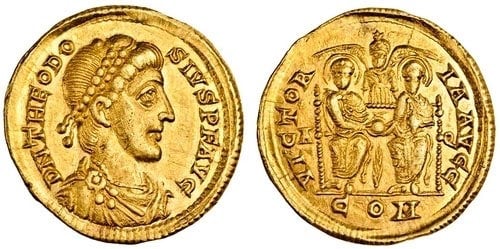
Some coins from ancient Rome are very rare because a small number of copies are known. An example of these coins is the Golden Medallion of Maxentius (Massenzio), known in only two pieces.
Among the other very rare Roman coins we can also include the Golden “Solido” of Emperor Theodosius I, that you can find on sale in more than splendid condition at 13,500€
Before the Roman Coins
Since the origins of Rome, trade and exchanges with other Mediterranean peoples have required practical innovation to make easier the exchange of goods. Initially, at the beginning of Rome’s history, the most widespread exchange method was barter, where goods were exchanged with other goods of equal value.
But this was not an optimal way to handle trade.
Roman Coins: Aes Rude
The first form of coinage was actually a sort of “updated barter”, in which the goods were paid with fragments and scrap of metalwork (usually bronze). They called these fragments “Aes rude“. They were not a classic coins and had no definite shape.
Their value was determined by the value and weight of the metal itself.
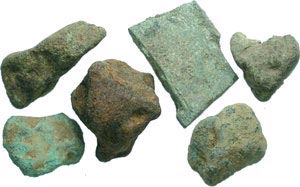
Roman Coins: Aes Signatum
Later on. They moved to the use of Aes signatum. They were bronze pieces of defined, round or rectangular shape. On the top of each piece there was the value and some symbols recalling the authenticity and authority of the issuer.
The oldest Aes signatum have few irregular traits reminiscent of a dry branch or herringbone. They were probably only grooves to facilitate gas release when melting into the mold.

Both the Aes rude and Aes signatum had a very variable weight (from 3 Kg to 3-400 grams) and are often found broken into fragments.
The next step for the “birth” of the Roman coins was the minting of the so-called Aes Grave. They were heavy round coins that began to circulate in the early days of the Republic.
Like the Aes signatums, the Aes graves reported on both sides the value of the coin itself and some representations of divinities with other symbols This one can be considered as the first ancient Roman coins.
Republican Roman Coins
With the introduction of these first Roman coins there was a distinction between different “denominations”.
Roman Coins: The Axis
The axis was the ancient Roman coin of greater value and weight. Initially, a Axis was weighing 273 grams. That is a weight that, with the progress of time and after a number of monetary reforms, experienced a substantial decrease.
Roman Coins Republican Fused
If at the beginning a Roman axis weighed 273 grams (one Latin pound) or 327 g (one Roman pound), it passed to half a Roman pound (163.5 g) in the second half of the third century BC.
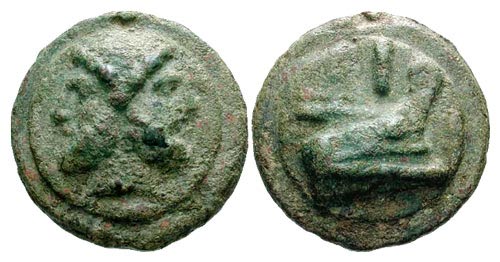
The axis then weighed 54.5 g after the reform of 214 BC. In 209 BC it weighed 27.25 g. The last reform brought the weight of one axle to 13.6 grams.
However, the value of the axis remained unchanged even though the weight gradually decreased. The value of coins that were fractions or multiples of the axis also remained unchanged.
Roman Coins: Multiples and Fractions of the Axis
Roman coins of multiple weight and value of the axis were: the dupondio (2 axes), the tripondio (3 axes) and the decussae (10 axes).
These are the Roman coins, which were fractions of the axis: the semisse (½ axis), the triente (1/3 axis), the quadrante (¼ axis), the sestante (1/6 axis), the oncia (1/12 axis) and the semi-oncia (1/24 axis).
In the most ancient series of Roman coins on one side of the coin was represented the bow of a ship. On the other side there was the profile of a divinity. (January, Jupiter, Minerva, Hercules, Mercury, etc.).

Other themes represented were related to rural and simple life of the time. You will find republican coins with shell, wild boar, dolphin, etc…..
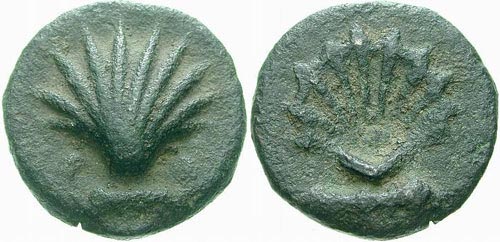
Because of their antiquity, these well-preserved coins can now reach a very high value from 30 to 200 euro.
All these coins were obtained by melting them into moulds but, with the expansion of trade with Magna Grecia, Rome began the minting of precious metal coins with the hammer.
Wrought Republican Roman coins
The first wrought Roman coins are known as Roman-Campane coins, since they were issued in the name of Rome and are most probably minted in Campania by Greek-Campani artisans.
They were mainly used for trade with Magna Graecia. In fact, the style of these republican Roman coins recalls that of the Greek coins.
Roman Coins: Dydyracma
The first republican Roman silver coin to be coined was Didracma, a double Dracma. He showed on one side Mars with the Corinthian helmet and on the other side an equine protome and the inscription “ROMANO” to indicate the coniation occurred outside the urbs but on behalf of the Romans.
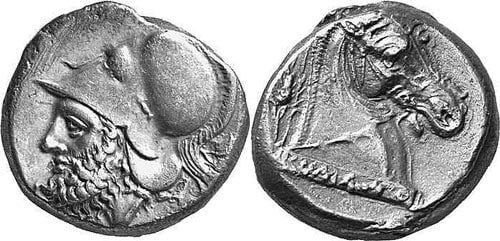
Later on, many other figures were added to the one of Mars, such as Apollo, Hercules, Minerva, Rome personified and the always present Janus.
The current value of a Didracma in good condition can be very high and even exceed 500 euro.
Roman Coins: the Denario
Around 211 B. C. (although this dating is still controversial) appears the Denario that will become the main Roman Coin until the time of Constantine, when it ceased to be coined.
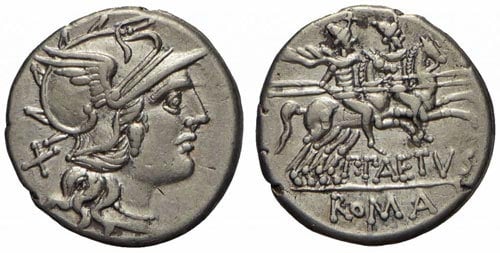
The weight of the earliest money was approximately 4.55 g. This Roman coin showed the head of Rome straight with the helmet and the Dioscuri on horseback and the writing “ROMA”.
These Roman coins can currently have a value of €50, which rises easily above €200.
If you have similar coins or some other piece you want to sell individually or in lots, you can rely on the partner we always use to buy or sell coins online: click here to open his site. (registration and item listing are free).
Roman Coins: Denario fractions
Roman coins were then introduced in fractions of the Denario, such as Quinario (½ denario) and Sesterzio (¼ denario). Both were in silver and coined sporadically during the Roman Republic.
Some gold coins were coined sporadically also during the Republic with the name of “Statere” and “half statere”. But it was with the birth of the Roman Empire that they began to be issued regularly.
Imperial Roman Coins
In the imperial period the first coin was made by Augustus. In 15 BC, he entrusted the emperor with control over the minting of gold and silver Roman coins. Coniation of minor values was delegated to the Senate.
Roman Coins: The Aureo
The Aureo (1/42 of a Roman pound, about 7.78 g) was the roman gold coin on which the entire imperial series of Roman coins was based. He had as multiple the Quaternario (4 aureo) and as submultiple the quinario (½ aureo).
The Denario and the Quinario also remained in use. For the minor values, the axis, the Dupondio and the Sestertium were preserved but minted in less noble metals such as bronze, copper and horical.

On the Roman imperial coins of lesser value, from the First Empire until the middle of the third century AD, the initials “S C” appeared. It meant “Senatus Consultum” to indicate the control and approval of the Senate at the emission of these Roman coins.
The current value of an Aureo, depending on conservation status and rarity, can reach very high figures, from 2-3000 euro up to 7000 euro.
For example, a Aureo “pietas augusti” in splendid conservation, a coin of the Emperor Gordian III, is valued at 7000 €.
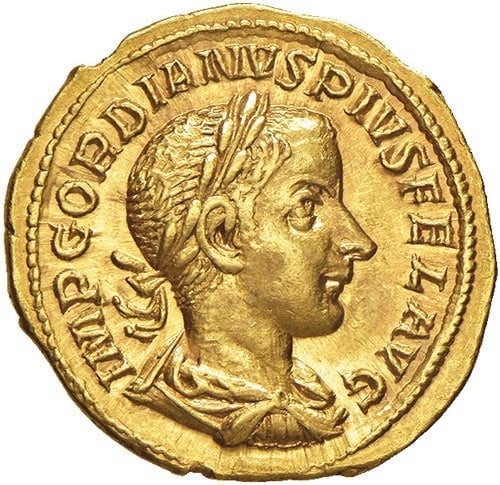
During the Empire, the Aureo Coin and Denario Coin experienced a progressive devaluation. The effective amount of precious metal contained in Roman coins decreased. In the end, a monetary crisis came about after the reform of Caracalla in 215.
Roman imperial rare coins
The rarest known imperial Roman coin is perhaps the Aureo medallion of Massenzio, known in only two pieces. A piece of this rare Roman coin was sold at auction on 5 April 2011. The price? It was sold for the astronomical amount of $ 1,407,550.
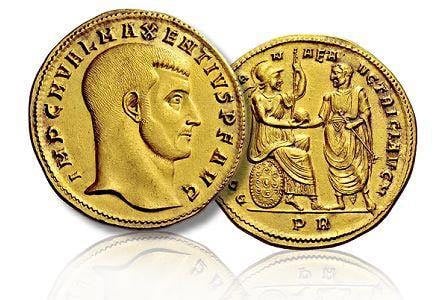
Legislation for Roman Coins in Italy
Currently, Italian legislation permits the collection and sale of ancient and rare Roman coins. This requires many measures, including the issuing of certificates of authenticity and proof of legal and non-illegal origin.
Archaeological research and also the search on the ground of ancient and rare Roman coins in Italy is forbidden to private individuals. It is allowed only to archaeologists engaged in authorized research and excavations.
If you happen to find a roman coin by coincidence, during the working of the fields or during a walk with the metal detector, how should you behave? By the way… Metal detector use is permitted but strictly bound and not allowed in archaeological sites or sites of archaeological importance)
Italian law requires that the competent authorities (Soprintendenza dei Beni Culturali, Carabinieri, etc…) should be immediately informed of the discovery. It also requires that the coins must not be removed from the discovery site, so that archaeologists can conduct all the necessary measurements.
Where can I find and buy Roman Coins?
Are you looking for rare ancient Roman coins and you’re wondering “where to find them”?
The best solution is to contact numismatics dealers or numismatic auction sites that guarantee the authenticity and non illegal origin of the same. We recommend that you read the page where we explain exactly how to sell or buy rare coins.
Or you can click here and register directly (it is free) in the largest numismatic auction site in europe.
You did not find what you were looking for? Check these topics:
- If you are looking for Euro Rare Coins then click here.
- If you are a numismatist and you want info on 2 Euro Commemorative Coins click here.
- The Rarest Lira Coin and their great value has been dealt with here.
- Pieces and their value of Italian 20 Lire Coin are described here.
- If you want info about Roman and Greek Coins and other Ancient Coins and their value, you can find it here
- We talked about how to clean the rare coins, here
- You will find everything about British Gold Sovereign Coins here.

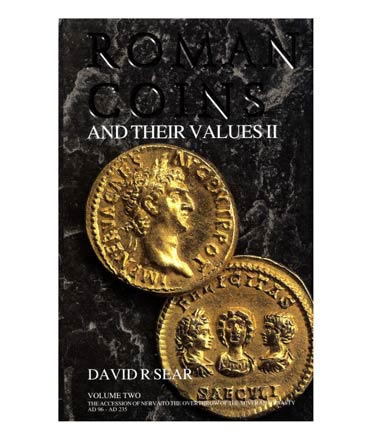
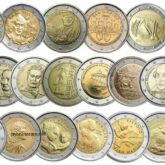
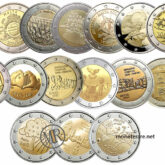
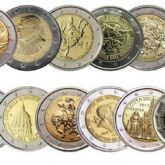
you can try to post some pics in our facebook group
i have ancients coin..but i dont know of which civilisation and i wanl to sell..can you help me about it?
just go in the aucions section of our website and check out some similar coins to look up the value.
I’ve got coins I would like you to value them Roaman Empire.